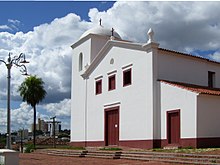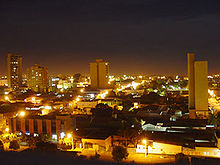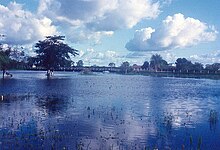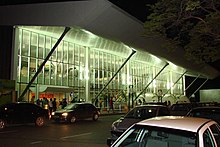| Revision as of 00:22, 6 December 2007 editOpinoso (talk | contribs)7,395 edits not true← Previous edit | Revision as of 00:22, 6 December 2007 edit undoOpinoso (talk | contribs)7,395 edits Festa Junina is not even celebrated in Mato GrossoNext edit → | ||
| Line 99: | Line 99: | ||
| Dance and music were traditionally connected to the worship of ] ]s, like ] (the city's ]) but has become lay lately. | Dance and music were traditionally connected to the worship of ] ]s, like ] (the city's ]) but has become lay lately. | ||
| ===] (Saint John Festival)=== | |||
| ] in Saint John Festival.]] | |||
| ] was introduced to Northeastern ] by the ] for whom St John's day (also celebrated as ] Day in several ]an countries), on the 24th of June, is one of the oldest and most popular celebrations of the year. Differently, of course, from what happens on the European ] Day, the festivities in Brazil do not take place during the ] but during the tropical ]. The festivities traditionally begin after the 12th of June, on the eve of St Anthony's day, and last until the 29th, which is Saint Peter's day. During these fifteen days, there are ], ], and folk dancing in the streets. Once exclusively a rural festivity, today, in Brazil, it is largely a city festival during which people joyfully and theatrically mimic peasant stereotypes and clichés in a spirit of joke and good time. Typical refreshments and dishes are served. It should be noted that, like during Carnival, these festivities involve costumes-wearing (in this case, peasant costumes), dancing, heavy drinking, and visual spectacles (fireworks display and folk dancing). Like what happens on ] and St John's Day in Europe, ] are a central part of these festivities in Brazil. | |||
| ===Carnival=== | ===Carnival=== | ||
Revision as of 00:22, 6 December 2007
Template:Infobox Brazilian State
Mato Grosso (pron. Template:IPA2) is one of the states of Brazil, located in the western part of the country. Neighboring states are (from west clockwise) Rondônia, Amazonas, Pará, Tocantins, Goiás and Mato Grosso do Sul. It also borders Bolivia to the southwest. Mato Grosso is the site of some of the worst deforestation in the world. A state with a flat landscape, alternating great chapadas and plain areas, Mato Grosso presents three different ecosystems: Cerrado, Pantanal and the Amazon Rainforest. The vegetation of the open pasture covers 40% of the state and the National Park Chapada dos Guimarães, with its caves, grottos, tracks and waterfalls, is one of its great tourist attractions. In the north is the Amazonian forest, with a huge biodiversity covering half of the state and the Xingu National Park and the river Araguaia are good reasons for a visit. Further south, the Pantanal, the world largest plain covered with water, is the habitat for almost a thousand species of animals, with many aquatic birds.
Geography

There we can find the Chapada do Guimarães, a scenery of unique beauty formed by sandy mountains that seem to have been cut, reminding of a city made of rocks. There are many cliffs, canyons and beautiful waterfalls.

And it is in Mato Grosso State where great part of one of the most intriguing places in the Country is located: the Pantanal, the biggest floodable region in the world, where the succession between floods and ebb tides gives origin to an unique feeding chain, populating the region with a varied fauna. Cutting across the Pantanal, the Transpantaneira - a mud road, full of small wooden bridges – allowing a parade among birds and mammals of the region along the path.
History
In 1977 the state was split into two halves, with Mato Grosso do Sul becoming a new state. The Bororo Indians live in the Mato Grosso area. As late as 1880, soldiers patrolled lands on the outskirts of Cuiaba, Mato Grosso's capital and largest city, to protect settlers from Bororo raids.

By the end of the nineteenth century, although severely reduced by disease and by warfare with explorers, slave traders, prospectors, settlers, and other indigenous groups, as many as five to ten thousand Bororo continued to occupy central and eastern Mato Grosso, as well as western Goias.
The historic remoteness of this area led it to be the subject of exploration, most notably by Captain Percy Fawcett, in the quest for lost cities. It was also the rumored location of access to the interior of the earth in various Hollow Earth theories.
Demographics


Ethnic groups
According to the IBGE of 2007, there were 2.866.000 people residing in the state. The population density was 3,2 inh./km². The last PNAD (National Research for Sample of Domiciles) census revealed the following numbers: 1.060.420 million White people (37.0%), 1.599.228 million Pardo people (55.8%), 174 thousand Black people (6.1%), 31 thousand Asian or Amerindian people (1.1%).
The majority of the Whites of the state is of Portuguese, Italian and German descent. The Pardos are a mixture of Europeans with the Blacks and/or Amerindians, varying from light to dark complexion. The Blacks are of African descent.
Urbanization: 76.8% (2004); Population growth: 2.4% (1991-2000); Houses: 791.678 (2005).
Source: PNAD.
Mato Grosso's demographics History
Many settlers started arriving in the late 20th century, mainly from Southern Region and Southeast Region of Brazil, attracted by the large quantity of free lands of the state.
Between 1940 and 1950, 2.300 Japanese people immigrated to Mato Grosso, to plant black pepper and clove.
The majority of the population has a mix of Portuguese and Amerindian ancestry (mamelucos).
Economy
The agriculture is the largest component of GDP at 40.8%, followed by the service sector at 40.2%. Industrial sector represents 19%, of GDP (2004). Mato Grosso exports: soybean 83%, wood 5.6%, meats 4.8%, cotton 3.3% (2002).
Participation in the Brazilian economy: 1.6% (2004).
Curiosity
Vehicles: 678.367 (jan./2006); Mobile phones: 1.6 million (2006); Telephones: 533 thousand (2006); Cities: 141 (2006).
Education

Portuguese is the official national language, and thus the primary language taught in schools. But English and Spanish are part of the official high school curriculum.
Colleges and Universities
Cuiabá is home to the following universities:
- Universidade Federal de Mato Grosso (UFMT);
- Universidade do Estado de Mato Grosso (Unemat);
- Universidade de Cuiabá (Unic)
- and many others.
Culture

Local culture is very rich, due to the multiple influences of many people, like the Portuguese, the Africans and the Indians. Two long periods of isolation also contributed to its differentiation, which has been a little diluted by recent immigration. Cuiabá has an interesting Indian-influenced cuisine, typical dances, craftwork and music.
Dance and music were traditionally connected to the worship of Catholic saints, like Saint Benedict (the city's patron) but has become lay lately.
Carnival

The four-day period before Lent leading up to Ash Wednesday is carnival time in Brazil. Rich and poor alike forget their cares as they party in the streets.
Museum
- Museu Histórico de Mato Grosso;
- Museu de História Natural e Antropologia;
- Museu de Arte Sacra;
- Museu Rondon;
- Museu de Pedras Ramis Bucair.
Tourism and recreation
- Alta Floresta


Excursions by boat
The Cristalino Jungle Lodge is along the banks of the Cristalino River. It can be reached by car and by boat from Cuiabá and it can offer trips to beaches along rivers where there the waters are crystal clear and the waterfalls are up to 40 meters high. Hikers” feet could sink up to 50 cm into leaves, vines and branches during hikes along the trails.
Fishing
For those who love fishing, the Thaimaçu inn offers the opportunity to fish large bass and varieties of Amazon catfish. The Thaimaçu is located along the banks of the São Benedito River, which extends for 250 km through a natural state reserve. Prince-consort Henrik of Monpezat, of Denmark, has already been to this veritable fishing paradise that can only be reached by car or by plane.
Fishing in the São Benedito region is productive practically all year long. However, the period when it is permitted to catch certain species may vary. The best chance of landing large fish is when the waters are at their highest levels (February to May). Fly fishing is apparently most indicated when the waters are at their lowest levels (August, September and October). Fishing is prohibited during the period when the fish are hatching their eggs, from December 1st to February 1st.
In this region, rivers such as the Juruena, Teles Pires and their tributary streams, which are tributaries of the Tapajós River, are true sanctuaries of beauty and excellent fishing locations.
Bird Watching: with the more than 570 species of catalogued birds and new species being discovered every year, the region of Alta Floresta and the Cristalino River Basin receives constant visits from famous ornithologists and bird watchers.
- Chapada dos Guimarães



Waterfalls
Véu de Noiva, Independência, Andorinhas, 19 de Novembro, Pedra Furada, Sete de Setembro, Cachoeirinha, Salgadeira and dozens of other waterfalls wash the soul of all those seeking an escape from urban life. The transparent waters descend and form natural pools in creeks and small pebble-filled rivers, where lambaris (small fish) swim, indifferent to the company of bathers. It is recommended to hire a guide to accompany you on this outing.
Mount São Jerônimo
One of the highest points in Mato Grosso at 1020 meters, it provides a fabulous panoramic view. The difficult walk to the top passes by curious sandstone formation, such as the Jacaré de Pedra (Stone Alligator), the Pedra Furada (Hole in the Stone) and the Mesa do Sacrifício (Sacrificial Table). The trail finishes after a 30-minute steep, uphill climb – inaccessible on rainy days.
House of Stone
This is a 70-square meter cavern with a stream and a light trail from the Park's Visitor’s Center. It also has cave pictures on the inside.
City of Stone
It is possible to walk by rocky formations, sculptured by wind and water and that formed along the cliffs of the Chapada, 350 meters high. The location is reminiscent of a city made of stone, which gave it its name. Access is made along a road that connects the Chapada dos Guimarães to the district of Água Fria, 24 km (15 mile) away.
Aroe Jari Cavern (Morada das Almas) (Home of the Souls)
The largest sandstone cavern in Brazil, Aroe Jari extends nearly 1550 meters and several pre-historic inscriptions can be found on the inside. Access is achieved over a moderate trail – 4.5 km (2.8 miles) long, an average 1 hour and 20 minute walk.
Lagoa Azul Cavern
This is a 30 minute walk from the Aroe Jari Cavern and it includes a lagoon with crystal clear waters where bathing is prohibited. Only 50 people are allowed to visit per day, and it is obligatory to hire a guide.
Paredão do Eco (Echo Wall)
This is a natural outlook formed by a huge sandstone wall at the top of the Chapada. Access is made along the road that leads to Água Fria, and then a secondary road that enters the Park.
Portão do Inferno (Gateway to Hell)
This is an 85-meter deep canyon that can be seen from the road that connect Cuiabá to Chapada (MT-251). It is possible to see the Cidade de Pedra from there.
- North Pantanal

Paraguay River
The Pantanal's backbone is the Paraguay River, which cuts through the region from North to South. The Miranda, Aquidauna, Taquari and Cuiaba rivers flow into the Paraguay River. From October to April, the high waters reveal outsized lakes, bays, river branches and outlets. A boat trip through this natural beauty provides wonderful sights.
Transpantaneira Highway
It connects the town of Pocone to Jofre Port, along the Cuiaba River bank. It is a dirt road with 126 wooden bridges, and extends for 149 km. On the way, it is possible to observe wild animals, especially alligators, capybaras and birds, among other wild animals. The best time for fauna observation is the early morning or at the end of the day. Many tourists travel it in one day, leaving from Pocone, having lunch at one of the inns on the way and returning in the afternoon.
Sesc Pantanal
SESC's Private Natural Heritage Reserve (RPPN) increases by one third the total area of this preserved ecosystem in the State of Mato Grosso. It leaves a legacy for future generations, which includes a rich sample of biodiversity for studies in agriculture, cattle-raising, aquiculture, biomedicine and wild fauna management. A reserve with these features not only guarantees official protection of a considerable part of the Pantanal and attends to the requirements of sustainable management – including fiscal benefits – but it can also stimulate the same type of initiative in other areas of Brazil, contributing to the establishment of a national system of conservation units.

Ornithology or Bird Watching
One hundred and sixty one different species of birds have been observed in the Pantanal. There are still many species in the area which have not yet been identified during the bird watching season.
Ecotourism
Horseback riding and boat rides, hikes to observe animals, photographic safaris – in four-wheel drive vehicles, on horseback or in canoes – and piranha fishing are the main attractions for those who want explore the exuberant Pantanal fauna. Some old cattle farms were adapted to receive visitors and offer these kinds of activity and tours for those visitors who enjoy ecotourism.
Infrastructure
International Airport


The runway at Marechal Rondon International Airport was opened to traffic in 1956. In February 1975, Infraero took over the airport's administration and began various upgrades to meet the needs of the airport complex.
As of 1996, Marechal Rondon International Airport, located 10 km (6.21 mi) from the city center, started receiving international flights. Currently it serves more than 500.000 passengers a year.
Highways
- BR-070;
- BR-173;
- BR-174;
- BR-158;
- BR-163;
- BR-242;
- BR-252;
- BR-364;
- MT-100;
- MT-358.
Sports
Cuiabá is one of the 18 remaining candidates to host games of the 2014 FIFA World Cup, for which Brazil is the only South American bidder.
Flag
The flag has the same colors as the national flag, with blue symbolizing the sky, green the vegetation, and white standing for peace. The star is yellow to symbolize the gold which attracted the first settlers. The flag was adopted by Decree No. 2 of January 31, 1890, just few days after the adoption of the national flag. The Mato Grosso state flag was abolished by Law No. 1.046 of October 8, 1929, but reinstated by article 140 of the Constitution of the State of Mato Grosso on July 11, 1947.
References
- Síntese de Indicadores Sociais 2007 (PDF) (in Portuguese). Mato Grosso, Brazil: IBGE. 2007. ISBN 85-240-3919-1. Retrieved 2007-07-18.
- Japanese Colony (PDF) (in Portuguese). Mato Grosso, Brazil: IBGE. 2006. ISBN 85-240-3919-1. Retrieved 2007-11-28.
- List of Brazilian states by GDP (PDF) (in Portuguese). Mato Grosso, Brazil: IBGE. 2004. ISBN 85-240-3919-1. Retrieved 2007-07-18.
See also
- Template:En icon Brazil
- Template:Pt icon Official Website
- Template:En icon Brazilian Tourism Portal
- Template:En icon Brazilian Embassy in London
- Template:Pt icon Brazilian Embassy in China
- Template:Pt icon Fderal University of Mato Grosso
- Template:Pt icon Mato Grosso's location on a 3D globe (Java)
| Regions and states of Brazil | |||||||||||
|---|---|---|---|---|---|---|---|---|---|---|---|
| Federative units |
| ||||||||||
| Notable archipelagos | |||||||||||
| Socio-geographic divisions | |||||||||||